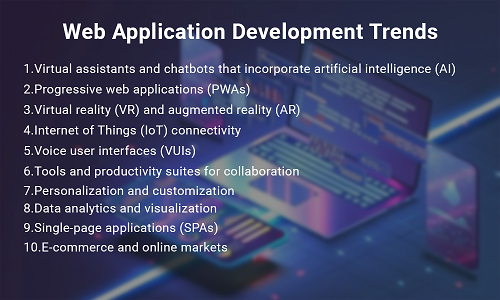Popular Trends for Web Application Development in 2023-2024
Chatbots are revolutionizing the way businesses interact with their customers, from customer service to tailored recommendations. To enable readers to build interactive conversational experiences, we cover free and open-source trends for web-based chatbot development in this article.
Web applications have become a crucial part of our digital existence and are used for a wide variety of tasks across numerous industries. The use of these web-based platforms to enable businesses to sell their goods and services online is a usual application in the field of e-commerce. They effectively handle tasks, including updating product catalogs, guaranteeing safe payment processing, and making personalized recommendations. Tools for communication and collaboration, which enable teams to work together effortlessly regardless of their physical locations, is another important application. These web tools boost productivity by enabling real-time communications, file sharing, and project management.
By offering platforms for online courses, virtual classrooms, and interactive learning materials, web apps have further made a significant mark on the education and e-learning sectors. They make it convenient for teachers and students to access learning materials at any time and from any location. Web apps are also essential for providing telemedicine services in the healthcare sector. They make healthcare app development more convenient and accessible by enabling remote consultations, making appointment booking easier, and ensuring the secure sharing of medical records.
The realms of banking and finance have found major use for web applications, too. They enable users to manage their accounts effectively, carry out transactions, and securely access financial data. These programs provide functions like seamless fund transfers, real-time account balance monitoring, and efficient investment portfolio management. Web apps offer online reservation systems for flights, hotels, and vehicle rentals in the travel and hospitality industry, automating the booking process and increasing client convenience.
Web applications are also essential tools for social media platforms since they give users a way to connect, exchange content, and interact with others. These apps include several features, including user profiles, news feeds, messaging tools, and multimedia-sharing capabilities. Web apps are also widely used in data analytics and visualization, allowing businesses to collect, process, and show data through interactive dashboards and charts in an appropriate manner. This makes it easier to make wise decisions and develop insightful ideas.
Web apps continue to evolve and revolutionize a variety of industries, providing innovative approaches and enhancing user experiences in the digital age, from e-commerce to education, communication to finance.
Web application use cases and recent trends
1. Virtual assistants and chatbots that incorporate artificial intelligence (AI):
By incorporating AI technologies in the healthcare sector, like machine learning and natural language processing, web apps are being improved. Advanced features like chatbots, recommendation engines, and personalized content distribution can be incorporated because of this connectivity. Web apps may provide users with more precise and personalized experiences by utilizing AI.
2. Progressive web applications (PWAs):
PWAs (progressive web applications) have attracted a lot of attention and are becoming increasingly popular. These web-based apps give clients a native app-like experience within their web browser. Push notifications, offline features, and faster loading times are just a few advantages of PWAs. They guarantee a seamless user experience while removing the need for clients to download and install conventional mobile apps.
3. Virtual reality (VR) and augmented reality (AR):
These are two technologies that have been merged with web applications to create engaging and immersive experiences. Web apps with augmented reality (AR) enhancements superimpose digital data on the physical environment to enhance how the user experiences and engages with their surroundings. Web apps with VR support, on the other hand, build virtual environments and involve users in new worlds. These technologies are revolutionizing how users interact with digital material across a range of sectors, including gaming, e-commerce, real estate, and training simulations.
4. Internet of Things (IoT) connectivity:
Web applications are increasingly used to manage and communicate with IoT devices. IoT-enabled web applications can connect with a variety of gadgets, such as wearables, industrial sensors, and smart home appliances. These apps act as a centralized interface that enables users to view and manage their IoT devices from a distance.
5. Voice user interfaces (VUIs):
With the rise of voice assistants like Google Assistant and Amazon Alexa, voice user interfaces (VUIs) have been integrated into web apps. Users using VUIs can communicate with web apps using voice commands. This functionality is especially useful for hands-free interactions, making voice-activated gadgets, smart speakers, and even in-car applications a good fit.
6. Tools and productivity suites for collaboration:
Web applications are used to enhance collaboration and productivity across a range of sectors. Remote teams can collaborate effectively via software like project management tools, document collaboration platforms, and video conferencing systems. Real-time editing, work delegation, file sharing, and communication functionalities are frequently included in these systems.
7. Personalization and customization:
Web applications are emphasizing more and more, offering users individualized experiences. These applications provide customized details, recommendations, and user interfaces by utilizing user data, preferences, and behavior patterns. Personalization is essential for boosting user satisfaction, conversion rates, and engagement.
8. Data analytics and visualization:
Web apps are essential for analyzing and displaying data in a clear and user-friendly way when it comes to data analytics and visualization. These programs gather, organize, and display facts so that users can gain knowledge and make wise choices. They are frequently used in fields including business intelligence, data science, and reporting. By allowing users to examine data through interactive dashboards and charts, they help people better comprehend the data they work with the app.
9. Single-page applications (SPAs):
As they are responsive and interactive, SPAs are becoming more and more widespread. SPAs eliminate the need for frequent page reloads by loading the entire application on a single web page. As a result, the user experience is improved, navigation is quicker, and performance is enhanced. SPAs are frequently employed for real-time communication, project management, and social media platforms.
10. E-commerce and online markets:
As e-commerce has grown, web apps have appeared that have been developed expressly for online retail and marketplaces. These applications serve as platforms for secure payment processing, personalized recommendations, effective product catalog management, and seamless online transactions. They also combine features like order monitoring, inventory management, and customer support systems to give users a complete and gratifying shopping experience.
Conclusion
In conclusion, for a web app development company in 2023-2024, staying ahead in web application development will require a keen focus on emerging trends such as progressive web apps (PWAs) for improved accessibility, leveraging AI and ML technologies for enhanced healthcare solutions, and many more to deliver agile and efficient web applications. Adhering to these trends will be essential for web app development companies to provide cutting-edge and secure web applications tailored to the healthcare industry’s unique needs and challenges.
Frequently Asked Questions (FAQs)
1. What are opportunities for web apps?
As they combine the best features of online and mobile applications, progressive web apps have a bright future. PWAs aim to combine user-friendliness, accessibility, and discoverability with mobile device capability.
2. How can progressive web apps (PWAs) benefit my web application in the coming years?
PWAs offer improved performance, offline functionality, and a more app-like experience for users, leading to increased user engagement and retention.
3. Are there any security considerations unique to healthcare app development that I should be aware of in 2023-2024?
Yes, healthcare apps should adhere to strict patient data privacy regulations (like HIPAA), implement strong encryption, and conduct thorough security assessments to protect sensitive health information.
Contemporary ventures
Recent blog
ready to get started?
Fill out the form below and we will be in touch soon!
"*" indicates required fields










